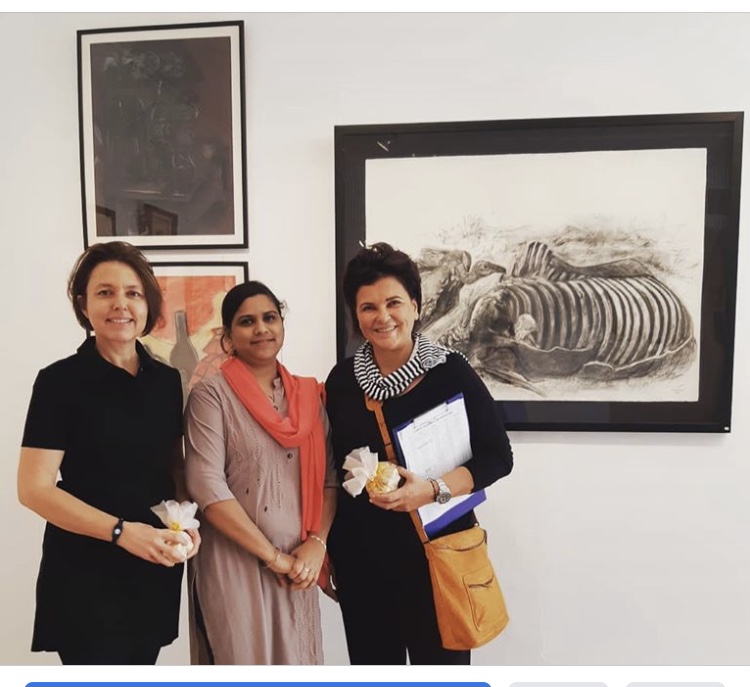TOPIC ONE THE WHITE CUBE
Exercise 4 Display
To the contemporary artist, this is quite an unfamiliar approach. Look at your work in the studio, choose a work – it could be finished or in progress, if it is on a table, place it on the floor, or if on a wall, or in a sketchbook, isolate it and give it its own space. Think about the colour of the floor/ wall, how much space is around the work and what is near it. How does the work change? What do you notice about it that you hadn’t before? Document your process and reflections in your learning log.
Choose a work:
In my workspace, my work is standing/lying/hanging around my work area – against the floor, on a table, in a drawer, in a box, hanging or in sketchbooks. Nothing is curated – it is a working space, quite chaotic. The walls are white, living a rental house and I always saw the space as a temporary workplace. I do consider the space they would/could hang in – some have been upgraded to the living room or bedrooms and framed, but here where I am at work I do not view them as ready. In many ways they are the focal point at the time when I work on them – then I consider them as how the viewer would see, feel or think about them, but not from a contained space, but as a work of art on their own. I feel safe with them here in my space – we are together and there is a flow of communication on what to do next, sometimes it is loaded with frustration and attempts that are complete ‘flops’ – a constant battle and reminder to continue.
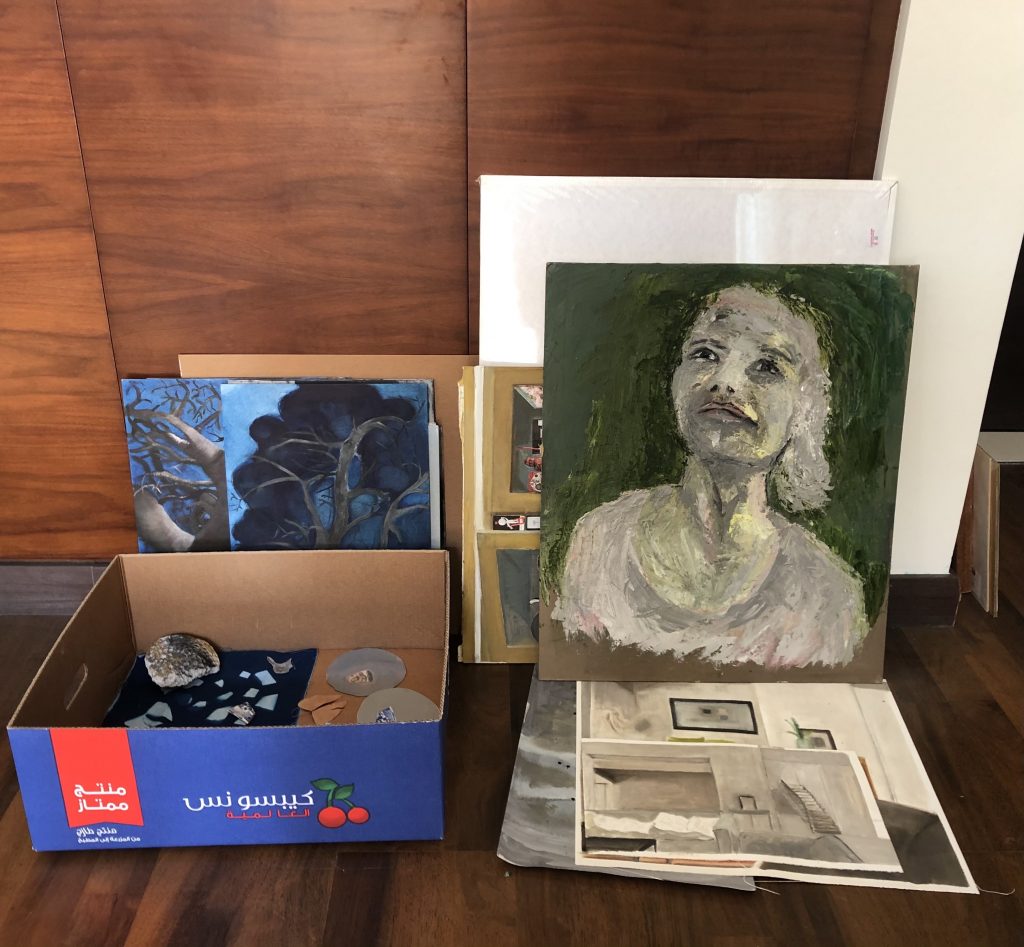
Floor view 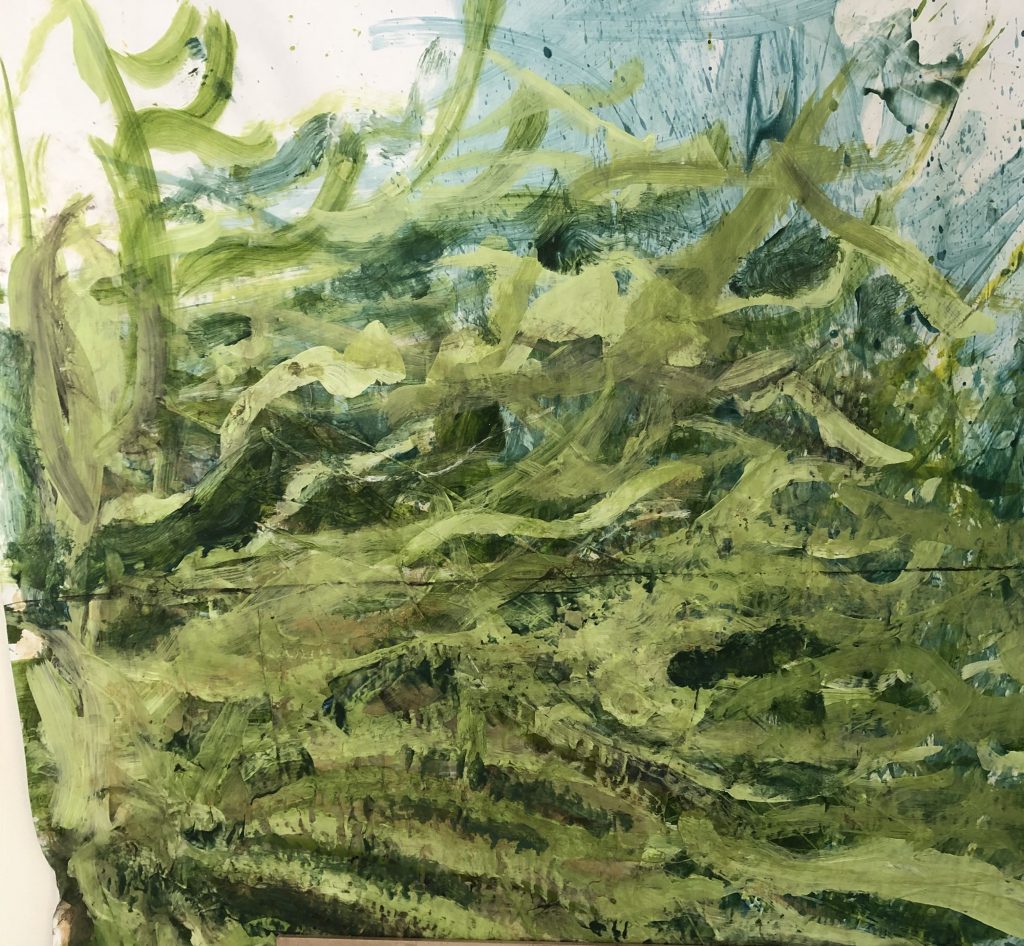
Stuck to the wall 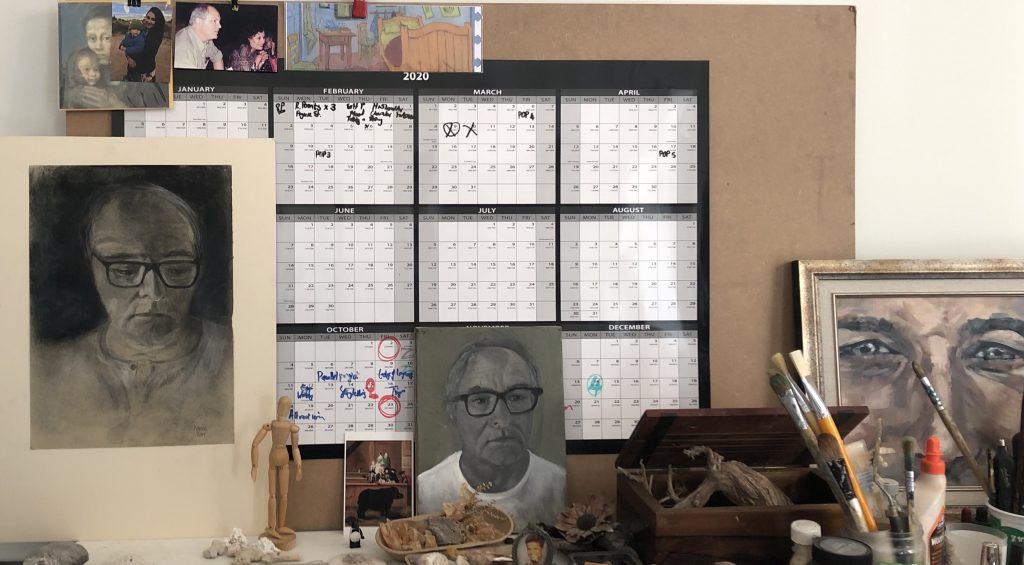
Table view 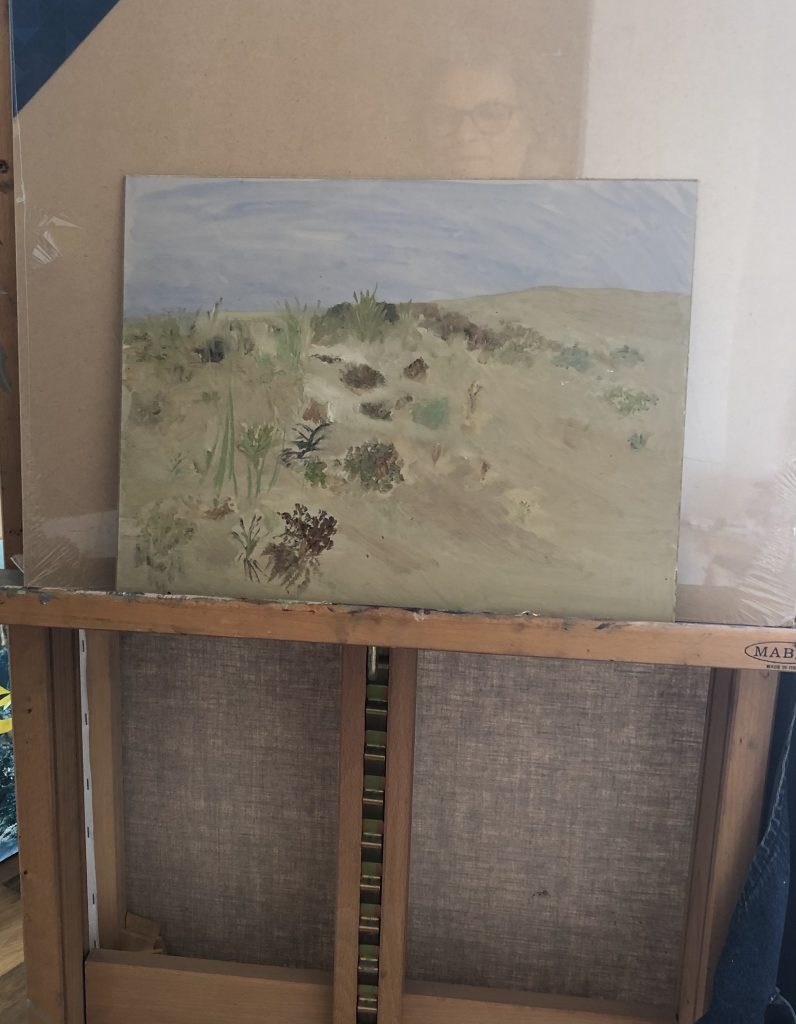
on the easle 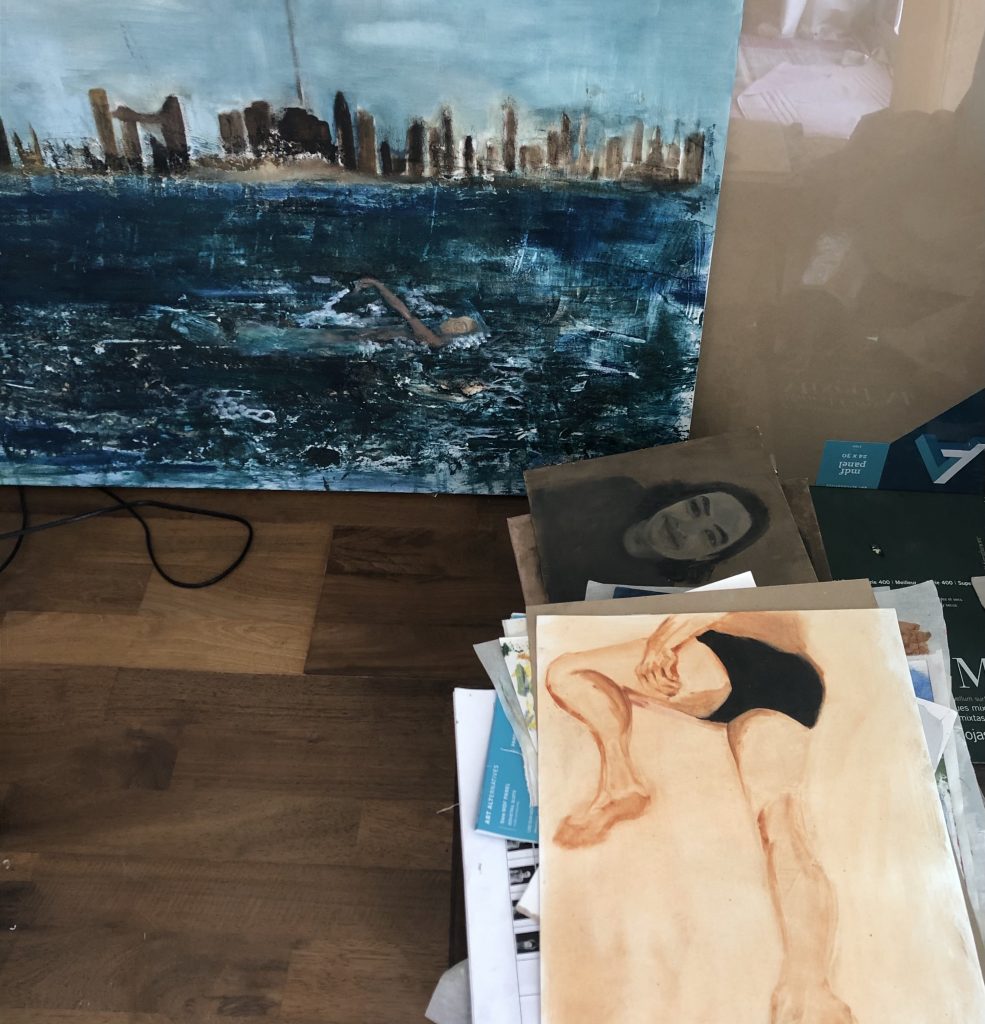
Isolate it, give it its own space :
Is the question prompting me to visualize and consider the functions of space on its surroundings, the environment around the work?
How meaning becomes a function of this space ( White Cube)?
It is about what a viewer expect to see when he/she walks into a gallery space – the focal and spatial expectations?
O’Doherty says the White Cube galleries replaced the frame and a relationship started between the viewer and the art work. How to think not about the work, but its surroundings on or against the wall, or another artwork, the space around it and how that will influence viewing experience – meaning ? Space can be seen as physical, mental and social dimension – we construct it by describing an embodied experience and this can be visible and invisible. My space where I work is a space I prefer to call a place of freedom – ‘no walls’ as walls that define space should not control what I set out to do. Its messy in many ways – the work does not aspire be seen as a sacred artifact, neither do I want to think it could hang in an ‘idealized space’, but I would like it to be part of the space where daily living is acted out. I am happy having it standing against the walls or lying on the floors – if you pick it up and view it, it should communicate with you from that place where it meets you.
O’Doherty writes: “The ideal gallery subtracts from the artwork all cues that interfere with the fact that it is ‘art’….So powerful are the perceptual fields of force within this chamber that once outside it, art can lapse into secular status. Conversely, things become art in a space where powerful ideas about art focus on them.” ( 1986,14)
Whilst I am making a work, stepping away and looking at it, definitely confronts me with the context of where I can see/envision the work. I take photos of the progress and this distance I experience on the photo helps to get back to the work with new questions to solve. I imagine a frame around it, or a room/space it would hang in, even what could hang next to it. I have looked at artists who use augmented reality/ renderings to show their work, as a marketing tool – I do not like this ‘reality’ when viewing work. I prefer to see images of closer up views and can imagine it myself in the ‘perfect’ space. Last year my work was hanging in a local gallery, it was intimidating and exciting to see it hanging with other works. (below image) I am grateful it was exposed here in Dubai as for me it was about the narrative around poaching of rhinos to be known by more people around the world. I hope to present the body of work as a series in the near future – in SA next year. I would like to present it in a context of education/information about the onslaught of the threat of animal trafficking/consumption.
Looking at these rhino drawings, it takes up a big space where it hangs in our living area.
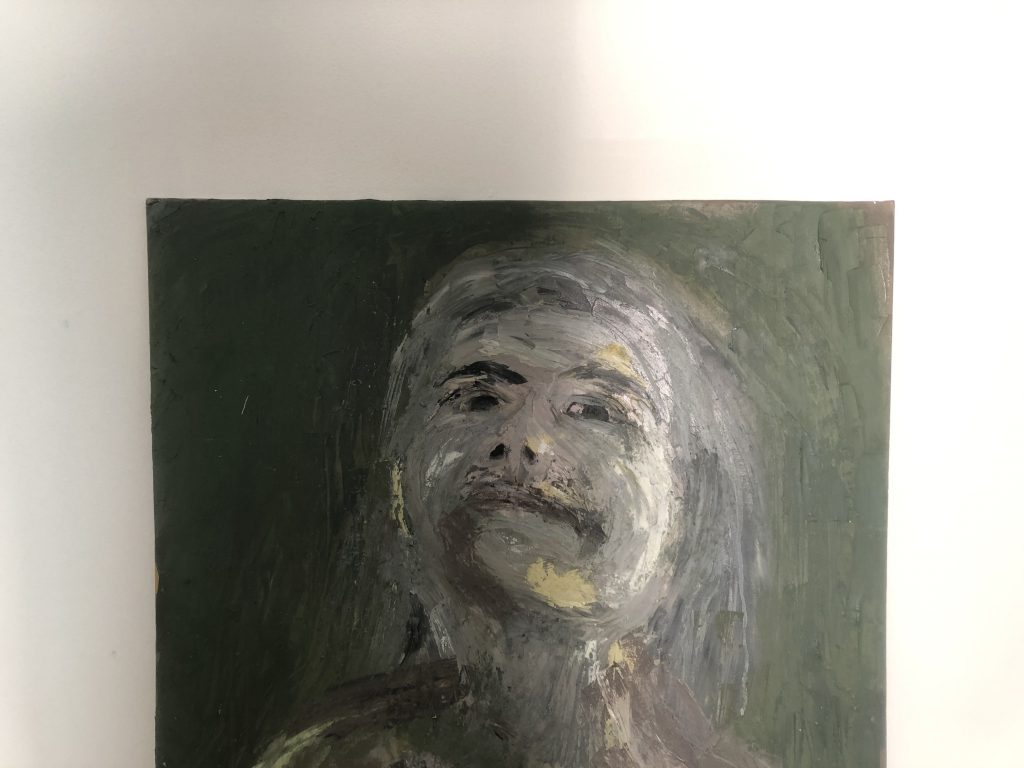
wip on white 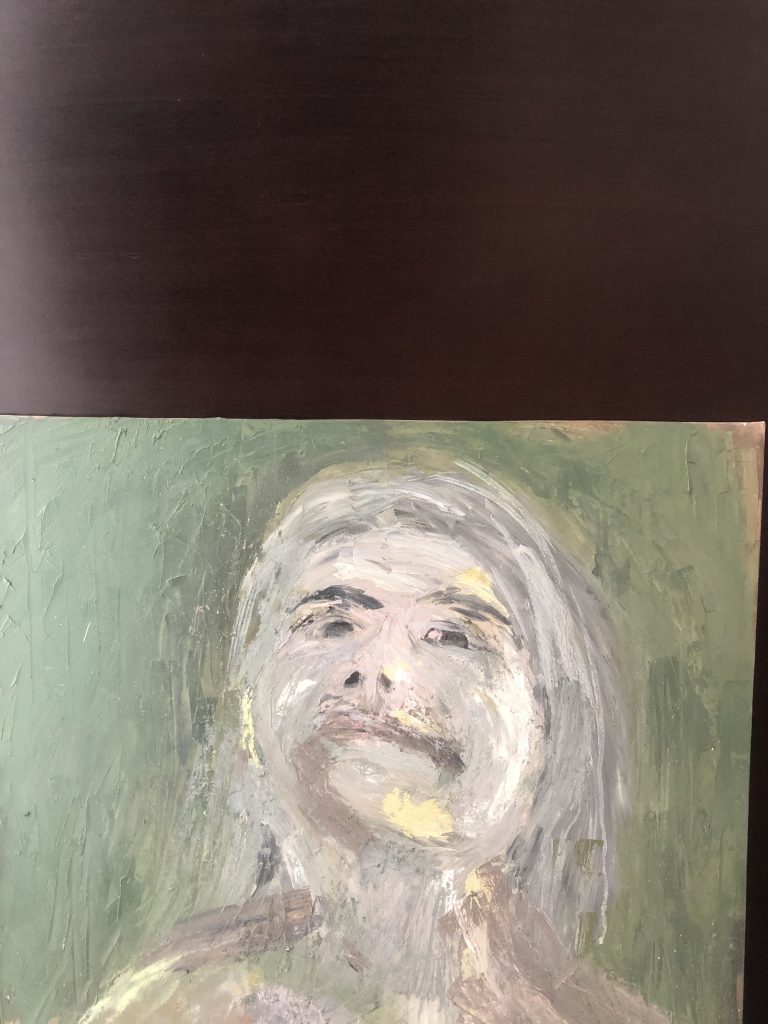
wip on dark
How does the work change?
Looking at above self portrait, a work in progress, I tried to imagine it on the white walls, or a dark background, shown in the photos above. It is work in oil on board, 60.5 x 50.5 cm in size. Now I am thinking of the hanging height against a wall, in a frame, or not in a frame, standing like a mantel piece on a table – I consider how will the light capture the face; I would like the viewer to see light as it moves from the top of the head to the neckline – revealing an experience of looking and being captivated by what is seen. The viewer should get close to see the making, how the paint was layered on the support and relate to the moments of quietness when looking at a tree canopy, as I was looking up/into. I am struggling to find a certain gaze, depicting form of a specific perspective ( how the face is in a upward gaze) but it is also a work about the underlying awareness I hope to be experienced. I do think that visual impact within a space where a work of art is presented plays an important role and that it can be used to manipulate and or create viewer experience. I can imagine it hanging next to a landscape or abstract work – diminishing in space.
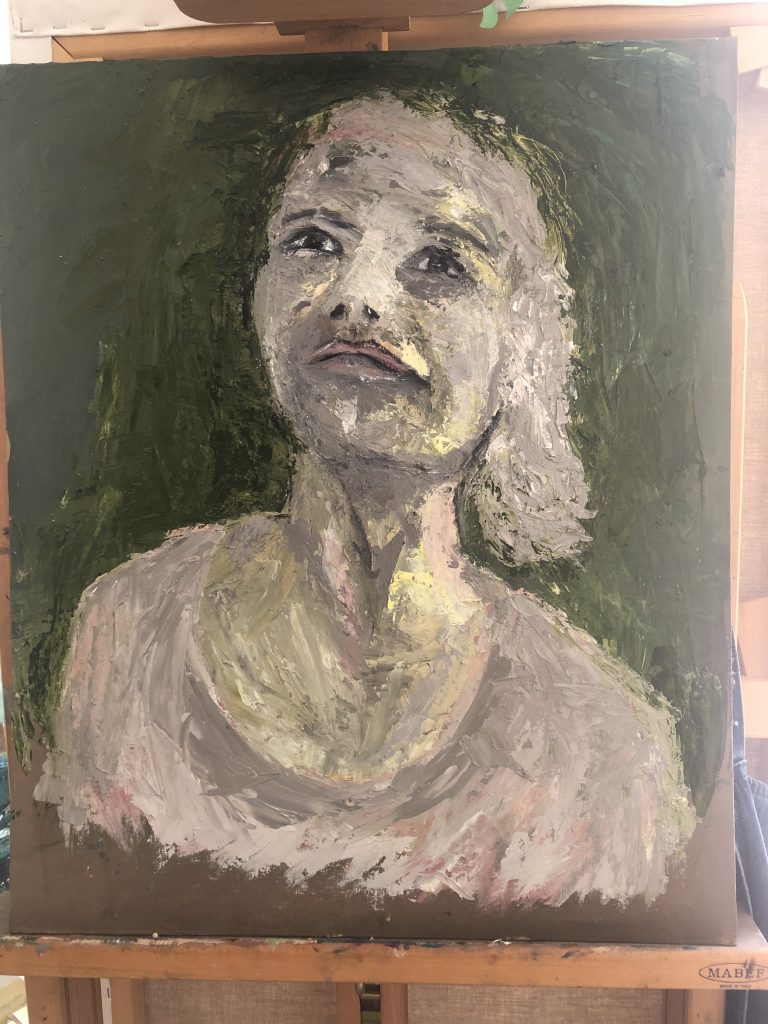
REFLECTIONS
I thought it important to think of the use of social media as a space where artist show/display their work and where the work is viewed and experienced in mostly uncontrolled places, very different from the place the artist would place it in a photo. Both artist and viewer rely on photography and language to have an interaction with art in real time – it is also the situation with sharing work for my studies, as everything is digital. In a recent interview with the Sunday Guardian, Indian multimedia artist Owais Husain (Owais Husain) said: “Much like the internet of things, the integration of everything and how we work today has contributed significantly to the mechanism of art and the artist’s practice. Your geographic location is now insignificant in relation to the platforms and formats on offer to position your art.”
Galleries are using their social media accounts to reach out to potential markets and customers as well as to improve their engagement. I wonder how big a role a curator would play in this difference scenario and how they would heighten context. The Plus One Gallery in London uses Facebook to highlight new work, and so promoting not only themselves but also new artists. I also think a challenge to the White Cube is the Art Fairs in many big cities around the world – although it seems they have grown too fast and the market has become very competitive and smaller and medium sized galleries could suffer even more.
In a video I watched of the White Cube, the director talks from his kitchen. They regularly engage with followers on Twitter, have life streaming events. Questions and ideas arising:
- do we refer to followers a viewers?
- Do the curators work with control in this space – I do think so, as they can use ‘algorithms” .
- But an algorithm can also be a collaborator, in a recent OCA workshop, a group used the computer to assign tasks of curating, and reported it took bias out of their choices.
- Rules like, be quiet, do not touch the work, does not apply in this space
- an artist can create his own exhibition and be in control of how viewers see this work and interact with it.
- Does it elicit enquiries about authority as barriers to entry is low and relatively easy to enter as an artist and/or curator
- Is this virtual space a more subjective experience?
- Is this becoming a conceptual space or is it a simulacrum?
In a recent student online conversation of OCA (OCA discuss, November 2, 2020) a student wrote that she is researching virtual galleries as a way of presenting her work for assessment. She asks fellow students about their experiences with these platforms, of which some are free. This is something I am also concerned with and have been looking at. An interesting comment which I found, was that of fellow Fine Arts student, Stefan Schaffeld. See image of his comments below.
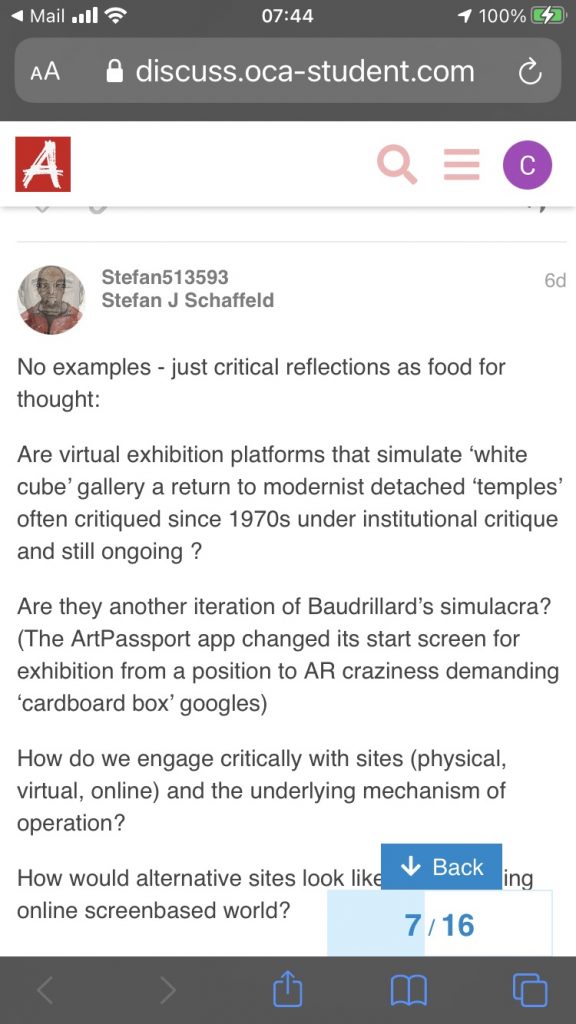
I think one finds a push to develop new ways due to circumstances ‘outside’ of the normal doing. I see the space as also using context and ‘devices’ to creating an experience of art for a viewer – will it change the meaning of a work? Here we also have curators who construct and arrange digital spaces. But then, do we need the ‘detachment’ as O’Doherty (and Stefan above) refers to when he writes that for him it ‘....often feels as if we can no longer experience anything if we don’t first alienate it. In fact, alienation may now be a necessary preface to experience.” (p 52) It seems we do need mediation for many of our experience to be ‘brought home’ – but should this be so important and done at the first encounter?
For the Viewer-literally something you look through-and
the Eye validate experience. They join us whenever we enter a
gallery, and the solitariness of our perambulations is obligatory,
because we are really holding a mini-seminar with our surrogates.
To that exact degree, we are absent. presence before a work of art,
then, means that we absent ourselves in favor of the Eye and Spectator, who report to us what we might have seen had we been
there. The absent work of art is frequently more present to us. (I
believe Rothko understood this better rhan any other artist. ) This
complex anatomy of looking at art is our “elsewhere” trip; it is
fundamental to our provisional modern identity, which is alwavs
being reconditioned by our Iabile senses. ror thi Spectator and ihe
Eye are conventions which stabilize our missing sense of ourselves. They acknowledge that our identity is itself a fiction, and
they give us the illusion we are presenthrough a double-edged
self-consciousness. Weobjectify and consume art, then, to nourish
our nonexistent selves or to maintain some esthetic starveling
called “formalist man.” All this is clearer if we go back to rhat
moment when a picture became an active partner in perceptio
I am thinking of the Impressionists who started working outside (practice development and focus on technique)…..how that changed their own view about how and what they wanted to do being artists who had to make a living, the marketing/exhibition of their work and about the potential buyers and viewers. Coming up against the Académie/Salon (state sponsored)who preferred carefully finished images that looked realistic when examined closely. The colours were somber and conservative – fitting with the galleries where they were shown. The jurors at the Salon carefully controlled/curated what, who and how they wanted art to be seen, and who would then buy – reaction was that this group of artists started their own exhibitions. Nobody was interested in the artist work techniques. If one then look towards M Duchamp one almost see a thread of artist reacting to the exhibition space – as the place where what they make should be shown to all interested, not just a selected group who control these decisions. The Impressionist by holding their shows could control what they included as well as how the work was presented to the public.
By now I did a search to see if my ‘theory’ holds. I find a doctoral thesis which covered most of my thoughts. (M Regan, 2004, Paul Durand-Ruel and the market for early modernism)
Here I read that Degas, for example, believed that the works should be mounted on walls painted a different color than the traditional red velvet of the Salon. He suggested that “rather than crowd works up, down, and across the walls, the Salon should install only two rows,” and the paintings in those rows should be “separated by at least twenty to thirty centimeters and positioned according to their own demands instead of those preordained by traditional patterns of symmetry. It is also clear that by now here was a middle class with a taste for art and looked at is as a commodity which could be a object to be purchased and displayed in middle-class homes. He also refers to a letter V van Gogh wrote to his brother, Theo, who worked as an art dealer, where he said, “You are as important as the artists you support, because without you we could no longer produce the art that is so important.” 85 I believe Monet took this further with his waterlily paintings – is he not reminding viewers that they are looking at how he used the materiality of paint to show his view of reality, but also keeping in mind where this should be viewed? His works were created for the Orangerie.
White Cube gallery, 2020 an Panelist discussion of the work of Danh Vo: ‘Traces of History and The End of Empire’ https://youtu.be/zpSLDJM8FYQ, published on 30 October 2020, accessed on 4 November 2020)
Beard, T. & Lonergan, G. (2008) “Interview with Guthrie Lonergan.” Rhizome [online]. Available from: http://rhizome.org/editorial/2008/mar/26/interview-with-guthrie-lonergan/ Accessed on 9 November 2020
Debatty, R. & Olson, M. (2008) “Interview with Marisa Olson.” We Make Money Not Art [online]. Available from: http://we-make-money-not-art.com/how_does_one_become_marisa/ Accessed on 9 November 2020
Wallerstein, Wade, Circumventing the White Cube: Digital curatorial practices in contemporary media landscapes online reading on anti materia,og website. https://anti-materia.org/circumventing-the-white-cube Accessed on 9 November 2020
Regan, M, 2004 Paul Durand-Ruel and the market for early modernism https://digitalcommons.lsu.edu/cgi/viewcontent.cgi?article=1122&context=gradschool_theses accessed on 10 November 2020.
READING POINT 1
The following comes from the OCA study notes:” According to O’Doherty, (O’Doherty, 1986:19) landscape paintings by artists such as Jean Désiré Gustave Courbet and Caspar David Friedrich begin to test the limit of the frame. In these works flatness, which can also be read as pattern, leads the eye to the frame and what lies beyond it. Additionally, the advent of photography affected how the viewer conceived the frame,
becoming aware that a photograph depicts an extract from a wider scene, which delineates a frame. Artists become increasingly interested in the environment in which art is shown and its presentation. The construction of the context becomes a subject as the conditions of perception become intellectual and integral to the work.” (p103)
Read some reviews or critiques of Brian O’Doherty’s Inside the White Cube. Begin with the link suggested below and continue to seek out further reviews or critiques: Cain, A (2017) ‘How the White Cube Came to Dominate the Art World’ [online]
I could download , Inside the White Cube, the essays as published in Artforum in 1976, and it seems the idea will be to see context as ‘the thing itself’ (content?) and its agency on the art object and the viewer – how it it became the object, instead of the artwork. (O’Doherty, 1986, p7) In the Cain article I read that O’Doherty became famous for ‘coining’ the phrase ‘white cube’ in 1976, but she reminds the reader that the idea of institutions exhibiting artwork, with an actual display strategy, is much older. Below is how Cain discussed the ‘historical construct of the gallery space and I find important form a historical view – learning from where it came and how it evolved.
Large private collections came in the hands of institutions, such as the Louvre (1793) and the British Museum (1759) with symmetrical arrangements which could lead to comparing styles and movements. With more viewers, the institutions realized that over crowded walls hampered desired appreciation of individual artworks – people could feel overwhelmed, what to say of sore feet and aching heads! I can just imagine walking through these huge areas as the image below, which is in the article and which I copied from The Met website. On the British Museum website the image is discussed and it is note that the the people wandering the exhibition, are ‘noble visitors wandering..’ I can just imagine trying to see the different works, on different heights. It looks more like an archive or ‘wunderkammer’ to me. Later I read about Gilman, the secretary of the Boston MFA who wrote about ‘museum fatigue”‘. I remind myself that I am part of the newer ‘context’ and how concepts of beauty and taste of where an artwork has been placed, has been part of how my viewing was shaped. In the article Cain mentioned that artists were captivated by the new public spaces, and museum galleries were a frequent subject of early 19th century painting – this obvious aided in more visitors who attended the institutions.
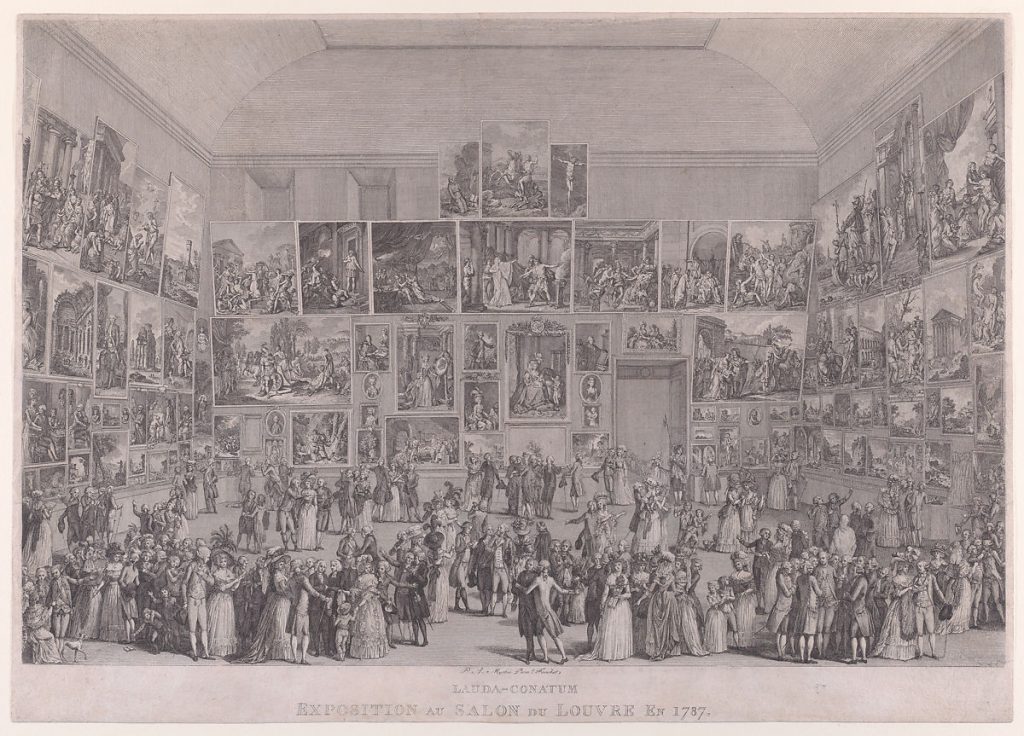
It seems by mid -1800 the National Gallery in London began to experiment with picture placement – by hanging the works on eye level and less works where the color scheme of the walls also came to play a role. Interesting to read how practical implications, such as overcrowding and storing works, became a problem – where to go to with works not being hung, and which to decide, when and where – curators did not exist. White walls became dominal choice of colour by the 1930 – interesting also the time when MoMa (A Barr) cemented their strategy for display, which is very much the white cube approach. I find it interesting when there is the connection made between the history of the white cube and modern art, as being ‘more or less inseparable’ and that professor of art history, A McClellan, still considers it the best display form of art in a gallery. Sheikh (Sheikh, 2009) writes about Gallery spaces and museums: “…and their ideology remains one of commodite feishism and eternal values(s)..” The struggle is an ongoing one- she discuss McClellan’s view that the hold of the White Cube has widened since O’Doherty’s essays. There is reference to commercial galleries which started in New York City – a crossover which happened as art being bought from the galleries are being given to the museums.
Reading about Brian O ‘Doherty, a trained doctor, turned artist and critic, I see his work as a critic on art’s perceived ‘dependence’ on the white cube as exhibition space, also being aware of what was happening outside the white cube space – like the role of ego (of the abstract expressionists at the time) and anti Greenberg sentiment amongst artists. In the video I viewed he said it was not consciously, but Greenberg was a powerful voice at that time One also needs to consider the the role of anti formal, or generated formalism. (Vimeo video conversation with prof Margaret Iversen)
In the essays one understand his review of the history above, and how he saw postmodernism broke from Modernism with artists starting to use the space around the work in the galleries – the walls, floor and ceiling became part of art which was displayed. (this will be discussed in Research Question 1) Artist saw that the gallery space is not a ‘neutral container’, but a historical construct, which tends to overpower the artwork. The white cube becomes the context. He also gave recognition to the social systems behind exhibitions, namely selling of works. Critical art should reflect on this space and continue to restage it as it does, because art is relevant to this shift.
A central argument in Brian O’Doherty’s influential Inside the White Cube, first published in 1971 (1986), is that in the twentieth century the spatial context of the white-walled art gallery becomes important to shaping our understanding of modern art because it is implicated in changes in the
relationship established between the viewing subject and the viewed object. The white-cube gallery ideal, he suggests, establishes a space constituted outside of time in which we, as visiting subjects, can relate to art objects on display as pure forms outside of their everyday context. The outcome, he argues, however, is not the confirming of some transcendental subject with a coherent experience of Art in keeping with this supposed blank space but
precisely its opposite: the alienation of the subject and the fracturing of experience into something multiple and incoherent when confronted with art objects that cannot be viewed contemplatively simply as pictures on a wall. Such a gallery type has this effect, O’Doherty believes, because the relationship between art (object) and viewer (subject) is one in which the
eye of the viewer becomes detached from the embodied experience, leaving behind an empty form of spectatorship and spectatorial experience. Collage, O’Doherty suggests, introduces this changed relationship between object and spectator because it calls into question the perspectival establishment of the viewing point as the point of the subject/eye around which viewing art has been premised in the modern past (see Panofsky 1991).
The Eye-subject was formerly constituted in the galleries of the past, and by all modern art up to and including Cubism, as a critically judging and discerning (albeit art obsessed) subject. Such a subject was capable, O’Doherty notes, of experiencing art in a disinterested and detached way. The spectator, on the other hand is, for O’Doherty, unable to distinguish the
difference between real space and art space in the white cube gallery because they have become blurred into one another by this unsettling of the relationship between coherent object and viewer, and indeed the walls of the gallery itself. Such a subject is prone, he believes, to sensation and impression and as such experiences not only art but their own sense of self as something fractured (1986) I conclude that he sees this space as a place that serve the need of a market in painting
I was particularly interested hat he commissioned Roland Barthes to write the key poststructuralist text The Death of the Author, which was published in this conceptual-exhibition-in-a-box, Aspen 5+6 (1967).
Bibliography
Buren, D. (1973) ‘The Function of the Museum’ [online] At:
http://faculty.winthrop.edu/stockk/contemporary%20art/Buren%20museum.pdf (Accessed on 4 November 2020
Cain, A 2017, How the White Cube Came to Dominate the Art World, published on the Artsy.net website, January 23, 2017 6:23pm Accessed on 2 November 2020
O’Doherty, B., 1986. Inside the White Cube: The Ideology of the Gallery Space. San Francisco: The Lapis Press
Drawing Room Conversations: Brian Doherty in Conversation, Vimeo, 12 October 2012
Sheikh, Simon, 2009, Positively White Cube revisited, E flux Journal, 03, February 2009. Accessed online on 4 November 2020.
Tate Modern Vision 2015. Retrieved from http://www.tate.org.uk/about/our-work/our-priorities/2014/04/04
Exercise 4.1: The gallery experience
How much of this view describes your own? Discuss with a friend or student your experience of visiting galleries and record your conversation in your learning log. These can be general memories and recollections, or if you have been to a number of different galleries, consider how they differ and the effect they have on you.
My own general memories and recollections:
I am reminded of the galleries in South Africa, The Johannesburg Art gallery (JAG today) and the South African National Gallery (ISANG) in Cape Town which I think I was privileged to get to know since I was a young child. The SA National Gallery is impressive as it stands in the old Kompanje (Company’s) Garden and was my first formal introduction to a museum for art. I did not understand a thing about the collections, but learnt to admire the works local artists as well as limited amounts of international art works, of whom I had seen prints in my family home. My childhood experiences of visits here is layered with some myth and that of privilege. If I am honest, we behaved around these objects as if in a church – but leaned to value these spaces filled with art and exquisite objects, which present value and history to me. I also realize know that these institutions were marketing to schools and forms part how my education was constructed. In many a way the experience is that of a unique chamber of esthetics, a place of sanctity and very formal.
I appreciate old buildings and architecture and the experience in these buildings are so different to that of the modern galleries which have a more light, modern building design which can be seen as a idealized place to view ‘high’ art, but the experience is diverse in terms of ownership and artists, have regular new exhibitions. Some of the high street minimalistic galleries which you enter and feel like they think you are there to steal or beg, do not make viewers feel welcome and comfortable to view their art. My first visit to the Vatikan to view the art (on my one) was annoying when I was ‘told’ to cover my shoulders (strapless dress), trying to get a glimpse of the La Pieta, behind a bulletproof glass case – the sanctity is overwhelming playing in to the function of this space. I found this more of a ‘”closed system of values” (O’Doherty 1976:14) as I had to be ‘wary of the space’ I entered, with art controlled by this system of hierarchy, which is mostly white men. I revel in the fact that museums and galleries are open to all and think critic should be ongoing – it shows all is alive and acting within a open system.
I do enjoy a ‘slower’ experience in the older galleries, love to revisit old favourite works and even find it annoying when they are temporarily removed. I love that time is then in my ‘control’ , as I can spend as much time where I want or feel the need to be. Adding to this, in a modern real white cube gallery in Johannesburg (Everard Read) the curator was willing to take me into their archives to see more works of a specific artist whose work I was interested to understand better. I do think this shows an openness to share and give me a wonderful experience within this space filled with art. In my mind I saw a place a space and art in conversation as I moved through these spaces. In the later years, the 90’s my local (SA) experience was that of interaction with contemporaries, open conversations with histories of colonialism, sexism, patriarchy, racism, identity politics.
My later experiences in museums in Europe (Paris, Rome, Amsterdam, Prague Barcelona, Vienna, Berlin) are very much the same. In Louvre and Musee d’Orsay I could go back in the evenings and make drawings. I could just listen and look at the viewers, mostly intrigued and engaged in what they saw. The highlight of my art viewing experience must be visiting Venice and the two yearly Biennale – the old buildings, churches or hotels, university rooms which are used to exhibit and interact with art, contribute to a wide range of experiences with art and artistic views – truly a global experience of art and artists. I have to make note of experiences online with museums and galleries – during the Covid pandemic it was my only viewing experience. I appreciate the regular curator talks and virtual opportunities to visit these spaces. I mostly walk away from a visit, touched and inspired to be a better person and to get to work and study
SA museums are institutions with serious concerns about their existence with issues ranging from budget constraints to maintaining the buildings the upkeep of restoration of works, archiving, donor relations, corruption and fear that the huge collections of treasures will be destroyed due to lack of restoration and proper archiving.
I shared the following questions with a few friends on WhatsApp:
How would you describe memories of visiting an art gallery?
M wrote: If I am visiting big galleries like Tate London, I prefer to wander around alone so that I can take my time, spend longer looking at the art that I like. Of course one’s mood can also influence one’s experience. My first memory of walking through galleries in Europe was the sheer size of the paintings and installations that I had seen for years only as ‘little’ pictures’ in books. Of course I was not prepared for the vibrancy of the colours used or the textures of the paint which only appeared as flat in the books that I looked at.
W wrote: ..there is nothing better than a physical visit, first you experience the actual gallery space which is usually with high ceilings, the proportion of art to the actual size of the room and the number of exhibits within that space. I love going at night when special lights are used. I usually try to see how the art was completed, vertical or horizontal, especially when it is over 2 m.
T wrote: mostly my memories are one of awe, contemplation, questions, wonder, satisfaction, feeling energized, enriched, challenged, opening my mind. But sometimes I am left puzzled, irritated, bored with art that did not speak to me
A wrote about a specific visit where the artist was also talking: ‘the crisp white minimalist space was suitably arranged by the artist’s etchings along the walls, a small etching press in the corner and chairs in rows for the small audience who came to hear not only the artist talk about her work, but also to see an etching demonstration.
Share a positive gallery experience and explain why it was so.
M wrote: A positive gallery experience is hard to explain, there were so many. Wandering through Salvador Dali’s museum in Figueras, Spain was awe-inspiring, shocking and humorous, while looking at Pre-Raphealite paintings in the old Tate brought up so many different emotions and a room full of Rothko’s took me somewhere else entirely and I found it hard to leave.
A wrote: Life can get quite lonely for an artist and this was a good opportunity to meet other artists and explore new ways of working. It was helpful to hear about her process and that she found her inspiration from visiting museums. I found it interesting that she did not always know what her work was about immediately after she had made it. Understanding sometimes took years for her and only then would she put her work on exhibition.
W wrote:My best memory is when I was 15 years old and visiting the Winter Palace in Russia.
T wrote:..was the exploration and discovery of the Impressionists/Post impressionists and how they made me see things that do exist but was never able to see on my own part. The literally let the peels fall from my eyes. This was in Musee De Orsay. I will never forget how deeply satisfied and enriched i felt by it.
Do you think online viewing of art is a good space to view and exhibit art?
M wrote: Online viewing has its place especially in this time of Covid, but one certainly does not get the full experience that one gets when walking into a space that has been set up by the artist or curator, all in particular order or sequence.
W wrote: I cannot have that experience online.
A wrote:Viewing art online enables the viewer to scan over lots of material very quickly, to read as much as you nave appetite for and then opt out easily when you’ve had enough. It reduces the gallery experience to the 2 dimensional artwork itself. Observing art in slow time forgetfulness may possibly be lost.
T wrote: In the absence of the real thing it is good and should be promoted. But it can never compare to being there, observing the total presentation, ambiance, fellow explorers.
REFLECTING on my own ideas on SPACE and PLACE as a starting point from where my practice resides.
Space is a palimpsest. Over time, it acquires layers of meaning by the way it is inhabited. These layers of meaning can be uncovered to understand space. What the space denotes is understood by looking at it from a distance with a “viewpoint”, but in order to uncover the embedded connotations, it is important to look at it from within by inhabiting it.
Reena Tiwari
(Tiwari, 2010:16)
A google search:
- Space is one of the classic 7 elements of art
- Space refers to areas around, between and within components of an artwork
- Space can be positive or negative
- Space can be open or closed
- Space can be shallow or deep
- Space can be two dimensional or three-dimensional
- Space can be an illusion of itself, not explicitly presented in an artwork
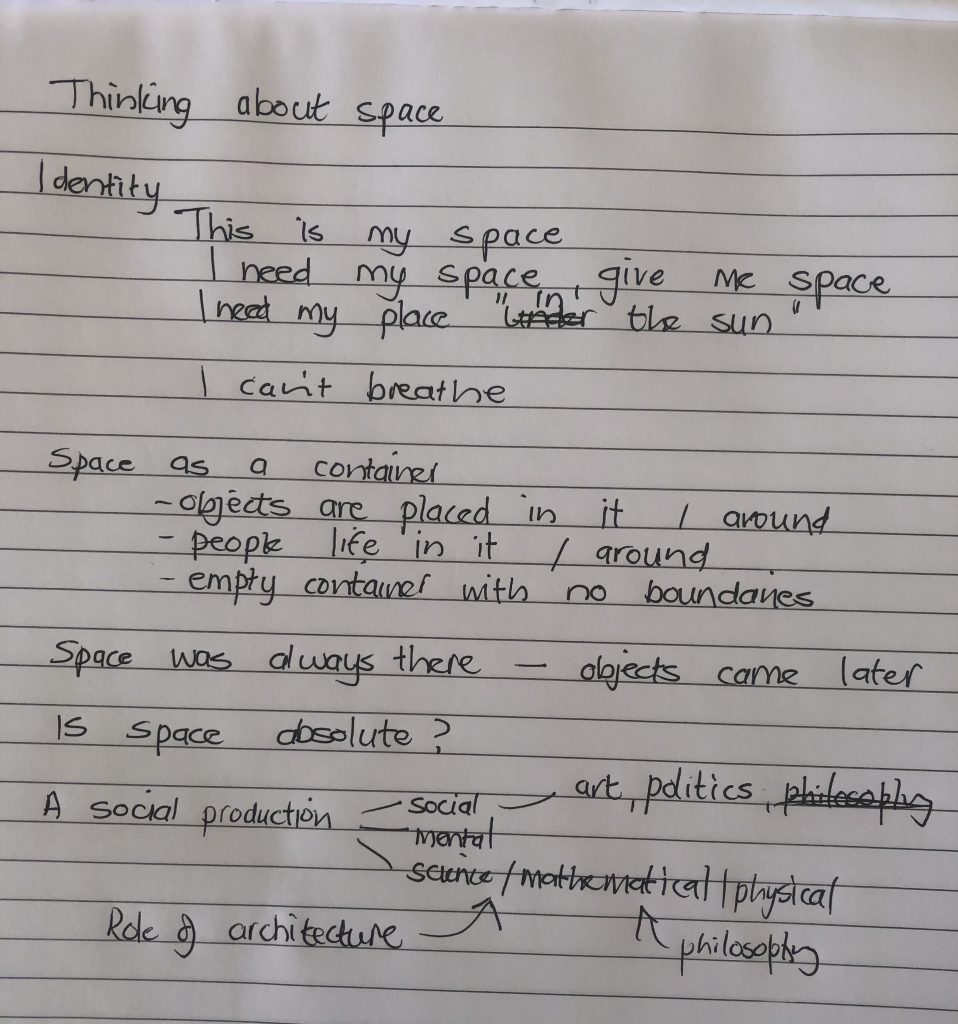
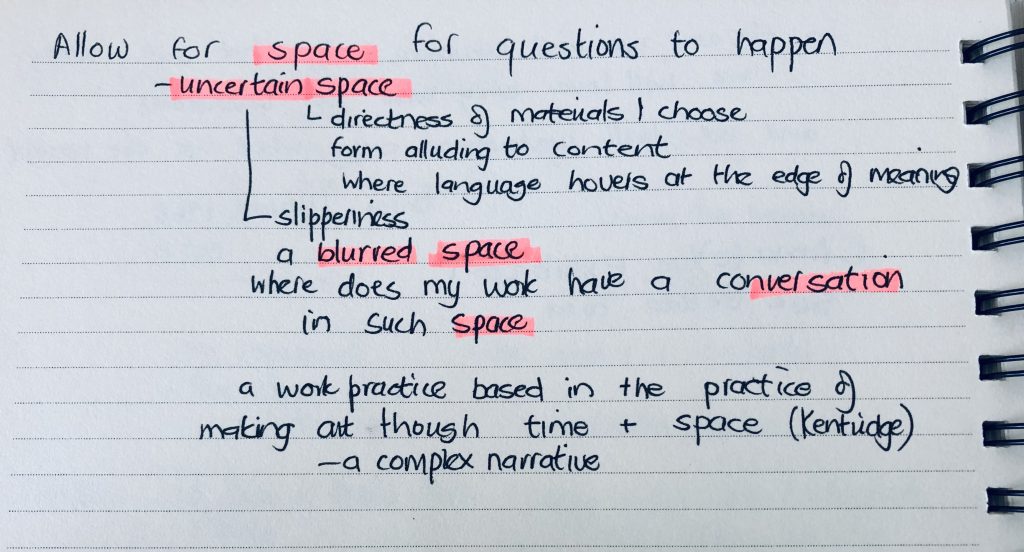
I walk to think, explore and recharge myself. Walking can happen in almost any space I find myself in, I do not even have to know a place to walk it – I can explore and experience by walking. In this way its a place which is lived in by me (and others) and where I happen to work/study. I confirm this idea with that of Henri Bergson when referred to by Dean and Millar (Place, 14) when they say: ” Place is thus space in which the process of remembrance continues to activate the past as something which, to quote the philosopher Henri Bergson, is ‘lived and acted, rather than represented“. I can also call it my environment. There are many places in this space – these authors write: “……there are many places within place, many regions, each with their own identities, dialects and dialectics” It seems many things come together in a space/place
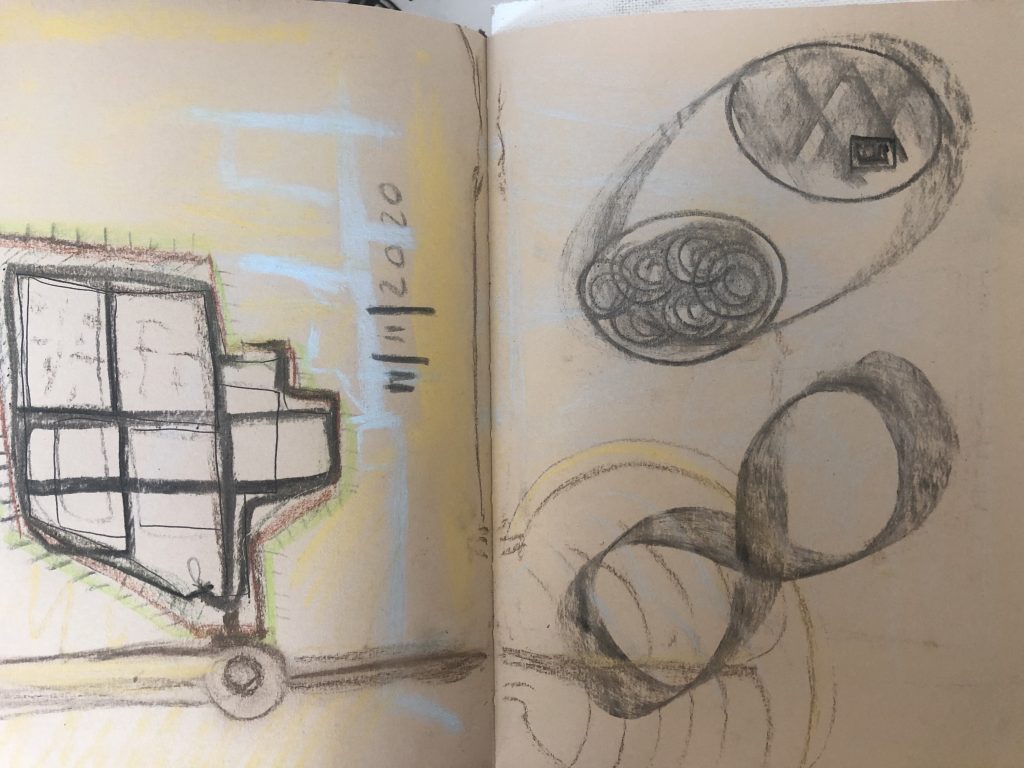
Art curators work with things within a space as/when they:
- “select, organize, and look after the items in (a collection or exhibition).”
- “select, organize, and present (online content, merchandise, information, etc.), typically using professional or expert knowledge.”
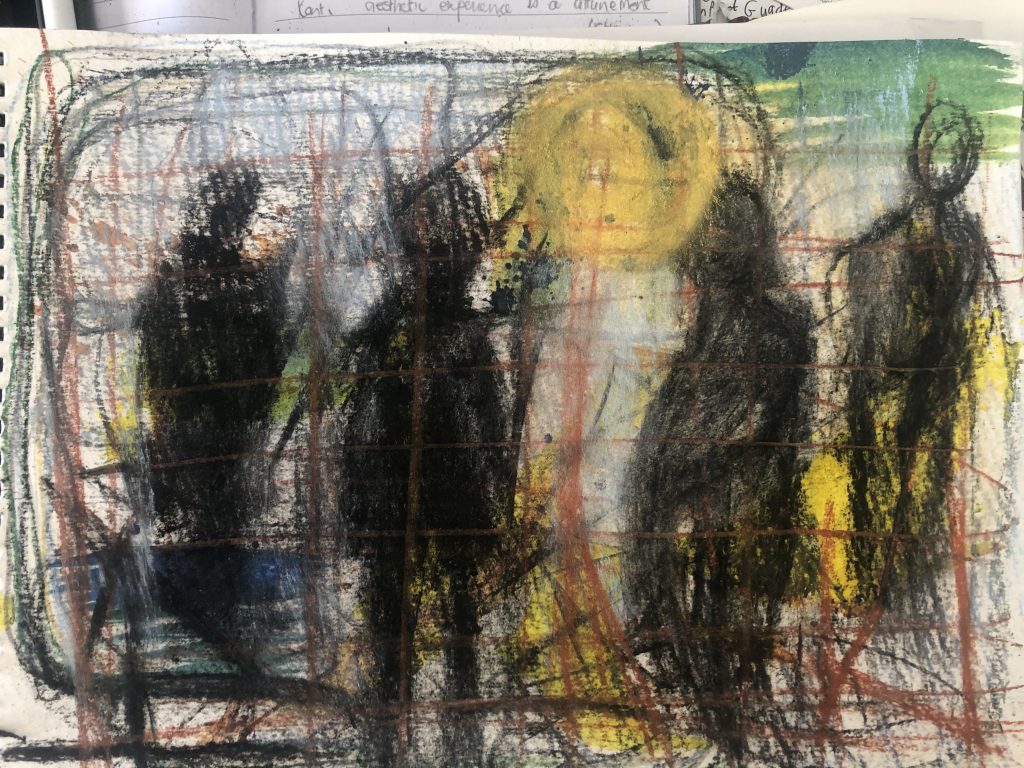
a drawing around my walking. I tried to think what a daily practice of drawing looks like if I used my other hand (Right hand, as I am left handed) I end up with confrontations of walking in a manmade area, enclosed. I see the selfies I take of my shadow as I walk.

I was thinking of the space around me as controlling my movement and the light of the sun to remind me of life and hope – as I walk I am reminded of a bodily action of movement, choice of how long and how far, how slow and fast I choose to walk within this ‘confined’ space – nobody is keeping me inside or witholding me from walking anywhere, I am not confined by the space I walk in. Fences were put up, but I can go beyond in my mind and take other routes – always other options how to react to fences. I pushed further the next day, after walking I was thinking that my mind might feel like a labyrinth.

I reconsidered this space where I live – it can be seen as a made made dream – it is on the edge of the largest man made palm shaped island. The sea was pushed back for man’s delight and development, a palm shaped island was formed – I find myself outside looking onto the island in the flat sandy landscape –
.

In dreams islands become a fantasy of an exotic holiday destination, a sort of paradise where you can enjoy being away and experiencing something other than your day to day life, or to the total other side find yourself to be isolated and even further away by being stranded/shipwrecked (survivor?). Interesting how the mind is full of constructed knowledge that came from stories heard, told, read and cinema and news….. Islands conjure many words, all indicate place occupied in mind or real at a time. Drawing with the pastel pencils I could create a sense of space by form with line and colour after at first drawing lines and marks. I did not attempt to create an accurate representation of a palm tree or the palm island.
It takes me back to the exercise I did about the Kenyan/British artist, Michael Armitage. I think that when his work was compared to that of Goya, Gaugin, Cezanne, Seuarat. Gaugin like other artists of his time visited places outside his home in a quest to develop his own ideas and find inspiration – the artists drew inspiration from a place to compose their own metaphors and ideas of their experience – time made a big difference in what was experienced, historic reference to colonialism and the male gaze is part of the history of the personal lives and choices these artist made within their practice. I like colour and texture and want to bring that into my work. I know that Cezanne was an avid walker – in his home province of Aix, this landscape was the subject of most of his work. Armitage saw the value of learning how Cezanne used colour and mark.
“Goya is one of the most important painters for me. His subjects and how and why he paints them have been fundamental to my own approach. Cézanne is important in terms of colour and mark, and Seurat for understanding the way colours work together.”
I read some more about Cezanne as I see in his work his relationship with things around him: ” What is especially interesting about this is that if we begin to understand what Cezanne did when he constructed his paintings, we find that Cezanne is not only a precedent for cubism but even more than that, he is the direct precedent for Jackson Pollock. In both cases, we experience their paintings as complex layers of color, networks of receding and progressing forms or lines, creating a sense of space which is true to the artwork but not true to real life or to the illusion of space which a painting more typically gives us, a perception which focuses on tension between colors and their movement but without experiencing this movement as real time. In other words, not only have distant and near space been compressed and expanded in multiple directions but present time and the sense of something unfolding over time have also been compressed and expanded simultaneously.”
